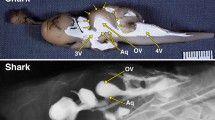Summary
Radiographic techniques have been applied to measure the size, volume and relationships of the posterior fossa, aqueduct and fourth ventricle in two strains of laboratory mice. Significant differences in the size of posterior fossae between strains were observed. Using ventriculography in the living mouse, the outflow tract of the fourth ventricle was demonstrated, together with a communication that exists between the third ventricle and the subarachnoid space.
Similar content being viewed by others
References
Bohme, B., Franz, B.: Die Binnenräume des Gehirns von Ratte und Maus, Acta anat. 59, 315–326 (1967)
Bonnevie, K.: Hereditary hydrocephalus in the house mouse. Skrifter utgitt au det norske vedenskaps akademi 1, Mat.-Nat. Klasse (1943)
Cox, K. O., Keast, D.: Erythrocyte auto antibodies induced in mice immunized with rat erythrocytes. Immunolgy 25, 531–539 (1973)
Festing, M.: Mouse strain identification. Nature (Lond.) 238, 351–352 (1972)
Levinger, I. M.: Special features of the rabbit cerebroventricular system, studied by the casting method. J. Anat. 109, 527–533 (1971)
Margolis, G., Kilham, L.: Hydrocephalus in hamsters, ferrets, rats, and mice following inoculations with reovirus type 1. II. Pathologic studies. Lab. Invest. 21, 189–198 (1969)
Philips, P. A., Alpers, M. P., Stanley, N. F.: Hydrocephalus in mice inoculated neonatally by oronasal route with reovirus type I. Science 168, 858–859 (1970)
Sheridan, M. N., Reiter, R. J., Jacobs, J. J.: An interesting anatomical relationship between the hamster pineal gland and the ventricular system of the brain. J. Endocrin. 45, 131–132 (1969)
Sidman, R. L., Angevine, J. B., Pierce, E. T.: Atlas of the mouse brain and spinal cord. Cambridge, Mass: Harvard Univ. Press. 1971
Westergaard, E.: Morphological changes in the lateral ventricles of the mouse brain during growth. Acta. anat. 59, 315–326 (1964)
Westergaard, E.: The cerebral ventricles of the guinea-pig during growth. Acta anat. 70, 382–402 (1968)
Westergaard, E.: The cerebral ventricles of the rat during growth. Acta anat. 74, 405–423 (1969)
Author information
Authors and Affiliations
Rights and permissions
About this article
Cite this article
Masters, C., Cala, L.A. & Hughes, T.D. Posterior fossa, aqueduct and fourth ventricle of the living mouse studied by positive contrast and plain radiography. Neuroradiology 11, 93–97 (1976). https://doi.org/10.1007/BF00345020
Received:
Issue Date:
DOI: https://doi.org/10.1007/BF00345020




